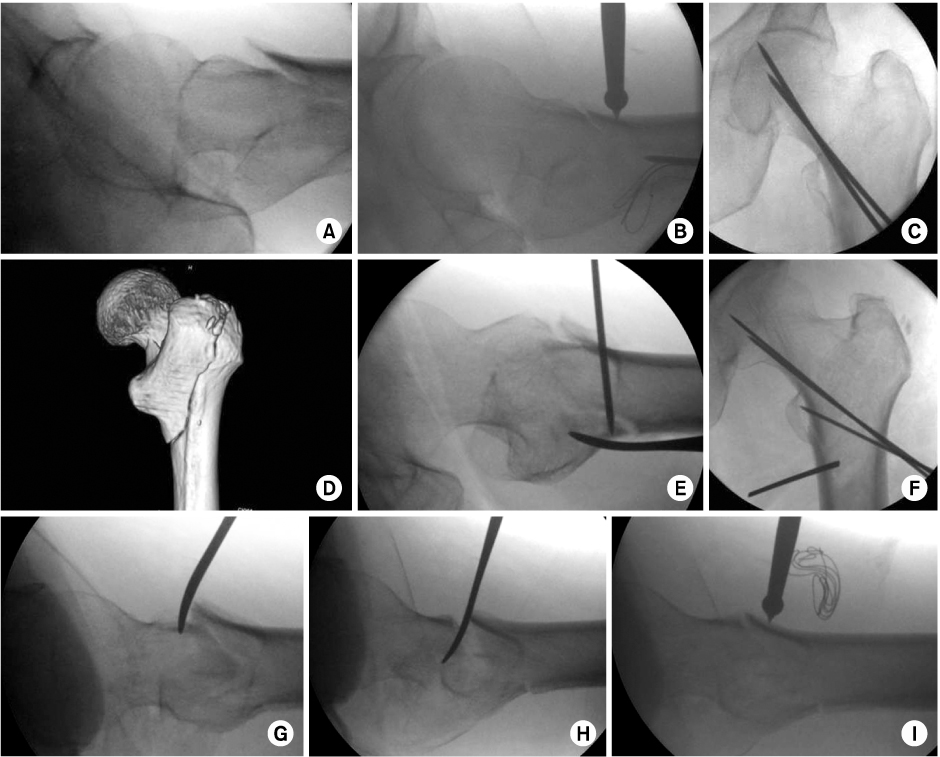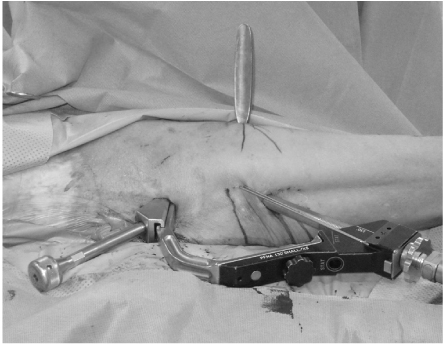J Korean Fract Soc.
2011 Jul;24(3):223-229.
Treatment of the Intertrochanteric Femoral Fracture with Proximal Femoral Nail: Nailing Using the Provisional K-wire Fixation
- Affiliations
-
- 1Department of Orthopedic Surgery, Kosin University Gospel Hospital, Busan, Korea. jyujin2001@kosin.ac.kr
Abstract
- PURPOSE
To evaluate the efficiency of provisional K-wire fixation in intertrochanteric fractures treated with proximal femoral nail (PFN).
MATERIALS AND METHODS
Twenty seven patients (by AO/OTA classification, A1 8 cases, A2 19 cases) were treated with PFN with percutaneous reduction and provisional K-wire fixation, and followed a mean 24.5 months. The adequacy of fracture reduction was assessed by Fogagnolo's classification and reestablishment of bone-to-bone contact with the medial anatomy. Functional results were evaluated by postoperative complications, Jensen's method and Harris hip score (HHS).
RESULTS
In all cases, the bone-to-bone contact with the medial anatomy was reestablished by percutaneous reduction and examination of Fogagnolo's classification showed a good reduction. The technical complications and error of starting point were not occurred. The mean HHS was 76.5 and means Jensen's grade was 2.1 grades. Complications included excessive sliding in 1 case and early cutting-out of screw in 1 case.
CONCLUSION
The provisional K-wire fixation in trochanteric fracture treated with PFN had an advantage in preventing technical complications because it facilitates a nail insertion in ideal position.
MeSH Terms
Figure
Reference
-
1. Albareda J, Laderiga A, Palanca D, Paniagua L, Seral F. Complications and technical problems with the gamma nail. Int Orthop. 1996. 20:47–50.
Article2. Apel DM, Patwardhan A, Pinzur MS, Dobozi WR. Axial loading studies of unstable intertrochanteric fractures of the femur. Clin Orthop Relat Res. 1989. 246:156–164.
Article3. Bendo JA, Weiner LS, Strauss E, Yang E. Collapse of intertrochanteric hip fractures fixed with sliding screws. Orthop Rev. 1994. Suppl:30–37.4. Bridle SH, Patel AD, Bircher M, Calvert PT. Fixation of intertrochanteric fractures of the femur. A randomised prospective comparison of the gamma nail and the dynamic hip screw. J Bone Joint Surg Br. 1991. 73:330–334.
Article5. Butt MS, Krikler SJ, Nafie S, Ali MS. Comparison of dynamic hip screw and gamma nail: a prospective, randomized, controlled trial. Injury. 1995. 26:615–618.
Article6. Carr JB. The anterior and medial reduction of intertrochanteric fractures: a simple method to obtain a stable reduction. J Orthop Trauma. 2007. 21:485–489.
Article7. Chang SA, Cho YH, Byun YS, Han JH, Park JY, Lee CY. The treatment of trochanteric femoral fracture with using proximal femoral nail antirotation (PFNA). J Korean Hip Soc. 2009. 21:252–256.
Article8. Desjardins AL, Roy A, Paiement G, et al. Unstable intertrochanteric fracture of the femur. A prospective randomised study comparing anatomical reduction and medial displacement osteotomy. J Bone Joint Surg Br. 1993. 75:445–447.
Article9. Fogagnolo F, Kfuri M Jr, Paccola CA. Intramedullary fixation of pertrochanteric hip fractures with the short AO-ASIF proximal femoral nail. Arch Orthop Trauma Surg. 2004. 124:31–37.
Article10. Gotfried Y. The lateral trochanteric wall: a key element in the reconstruction of unstable pertrochanteric hip fractures. Clin Orthop Relat Res. 2004. 425:82–86.11. Gundle R, Gargan MF, Simpson AH. How to minimize failures of fixation of unstable intertrochanteric fractures. Injury. 1995. 26:611–614.
Article12. Haidukewych GJ. Intertrochanteric fractures: ten tips to improve results. J Bone Joint Surg Am. 2009. 91:712–719.13. Haidukewych GJ, Israel TA, Berry DJ. Reverse obliquity fractures of the intertrochanteric region of the femur. J Bone Joint Surg Am. 2001. 83:643–650.
Article14. Harris WH. Traumatic arthritis of the hip after dislocation and acetabular fractures: treatment by mold arthroplasty. An end-result study using a new method of result evaluation. J Bone Joint Surg Am. 1969. 51:737–755.
Article15. Hong KD, Sim JC, Ha SS, Kim JY, Kang JH, Park KH. Operative treatment with ITST in femur trochanteric fracture. J Korean Fract Soc. 2008. 21:274–278.
Article16. Im GI, Shin YW, Song YJ. Potentially unstable intertrochanteric fractures. J Orthop Trauma. 2005. 19:5–9.
Article17. Jensen JS. Determining factors for the mortality following hip fractures. Injury. 1984. 15:411–414.
Article18. Jeon HS, Park BM, Song KS, Kim HG, Yun JJ. The Comparison between ITST(TM) (Intertrochanteric/Subtrochanteric) & DHS (Dynamic Hip Screw) in unstable femur intertrochanteric fracture. J Korean Fract Soc. 2009. 22:131–137.
Article19. Kim CK, Jin JW, Ahn BW, et al. Intertrochanteric fractures of femur treated with a proximal femoral nail. J Korean Hip Soc. 2005. 17:99–105.20. Kim SD, Sohn OJ, Cho JH. Comparison study of intertrochanteric fractures treated with intertorhanteric/subtrochanteric fixation with a standard vs a mini-inicion. J Korean Fract Soc. 2008. 21:1–7.
Article21. Kim SY, Noh JH. Management of femoral peritrochanteric fracture with proximal femoral nail. J Korean Orthop Assoc. 2006. 41:541–546.
Article22. Kwak KD, Ko CU, Ahn SM, Ahn KB. Choice of internal fixatives for the intertrochanteric fractures of the femur in the elderly. J Korean Fract Soc. 2005. 18:385–389.
Article23. Lee JY, Kim SH, Song JH. Surgical treatment with proximal femoral nail for intertrochanteric fracture of the femur in elderly patients. J Korean Hip Soc. 2008. 20:1–6.
Article24. Oh JK, Hwang JH. Osteoporotic pertrochanteric fracture: IM nailing. J Korean Fract Soc. 2009. 22:56–65.
Article25. Parker MJ. Cutting-out of the dynamic hip screw related to its position. J Bone Joint Surg Br. 1992. 74:625.
Article26. Sohn SK, Kim SS, Kim CH, Lee MJ, Kim SK. The surgical treatment of proximal femoral nail for peritrochanteric fracture of femur. J Korean Hip Soc. 2003. 15:253–257.27. Sung YB, Sohn YJ, Yum JK, et al. Proximal femoral nail (PFN) for intertrochanteric fracture -long-term follow-up results-. J Korean Hip Soc. 2005. 17:141–148.28. Walsh ME, Wilkinson R, Stother IG. Biomechanical stability of four-part intertrochanteric fractures in cadaveric femurs fixed with a sliding screw-plate. Injury. 1990. 21:89–92.
Article
- Full Text Links
- Actions
-
Cited
- CITED
-
- Close
- Share
- Similar articles
-
- Fixation Failure of Proximal Femoral Nail Anti-rotation in Femoral Intertrochanteric Fracture
- Removal Methods for Broken Proximal Femoral Nails Using Ball Tip Guide Wire: Technical Note and Two Cases Report
- Treatment of Femoral Intertrochanteric Fracture with Proximal Femoral Nail
- Femoral Neck Fracture After Removal of the Intramedullary Nail for the Fixation of an Intertrochanteric Fracture: Report of 2 Cases
- Surgical Treatment of Ipsilateral Multi-Level Femoral Fracture Treated Using Antegrade Intramedullary Nail





